#Academic Enrichment
Text
International Education Center
Discover the transformative power of international education at our International Education Center. Explore opportunities for cultural exchange, academic enrichment, and personal growth on a global scale. Join us as we delve into the benefits and experiences of studying abroad and fostering cross-cultural understanding.
1 note
·
View note
Note
show me the lobotomy corp ocs. what is caeru doin in the city. whats his backstory.
very funny that the Scoundrel is there. girlthing that wants to stop being human in the city ruled by the CEO of prohuman racism
i have no idea what their backstories are because my knowledge of project moon lore is incredibly flimsy and full of holes wide enough to drop a city through 👈😎👈
knowing both of them, caeru has been through absolute hell and the scoundrel is a pampered yet miserable rich kid who's never worked a single day ever in their life (up to this point). some things are simply omniversal
#callie rigel and reguel are also all hangin out with cards in the control team#even if i havent posted about them lately. i couldnt in good conscience leave out my favorite child (and vague associates)#ask#lobotomy corporation#i would move caeru to the control department so i could have a full oc squad goin#but that would require separating him from the inherent enrichment of being a little academic guy#and also his current title is captain of the information team. i cant simply not keep him there#im sure the scoundrel can get in on some robot transhumanism swag. or something. there's probably a cyborg transplant shop somewhere#this feels like the kind of verse to have a cyborg transplant shop
16 notes
·
View notes
Note
What's a ballet with real snazzy costume work, in your humble and/or professional opinion? c:
Oh, you’ve activated my trap card - asking about costume design and ballet and not expecting me to barf up the entirety of my PhD. I’ve also done work on the ballet blancs costumes (Giselle and La Sylphide specifically) but they are interesting on a theoretical level and not so much visually, so I’ll skip that.
So here are some personal favs of mine - the highlights, if you will. Caveat: long post, and mostly limited to the work of the Ballets Russes, because they are my longtime obsession and I think (and have argued) for their role in fundamentally changing stage and costume design (to say nothing of dance, and George Balanchine can sit the fuck down). I didn’t put that in my thesis but I wanted to.
Anyway tldr in the first decade of the 20th century a troupe of dancers from the Russian Imperial Ballet (later the Mariinsky) travelled through Europe under impresario Serge Diaghilev, for what became known as the Saisons Russes, or Russian Seasons. They performed both opera and ballet, and are probably best remembered today (if at all) as the troupe that danced the premier of Stravinsky’s Rite of Spring and caused a riot at the Theatre des Champs Elysées. The eminent artists that worked with them include Debussy, Cocteau, Picasso, Chanel - and these are only a few recognisable names. But my focus was primarily on the Russian roots of the ballet, in their visual language and presentation of gender and nationality, more precisely around the work of artist Leon Bakst and dancer Vaslav Nijinsky.
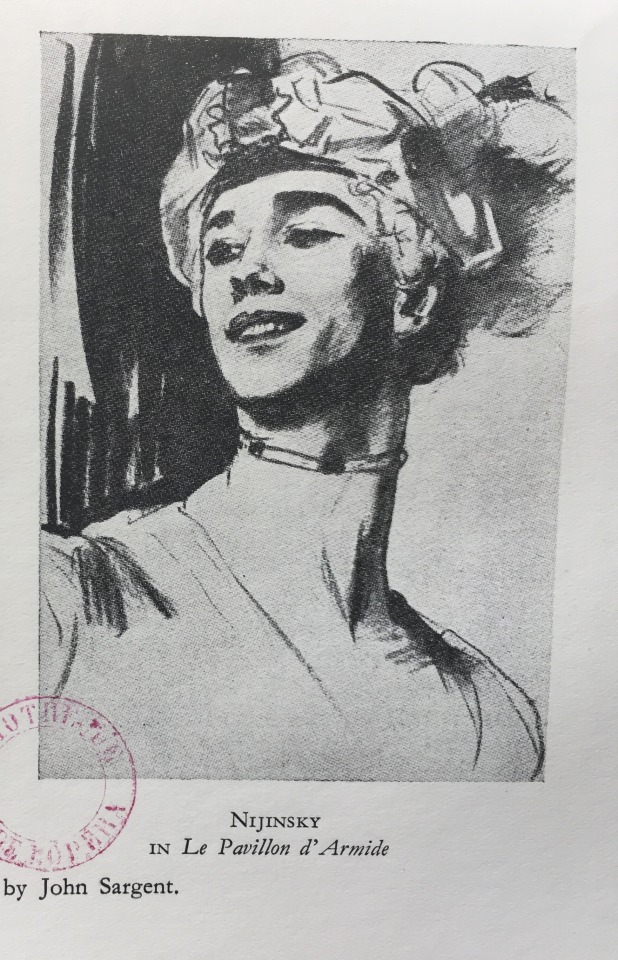
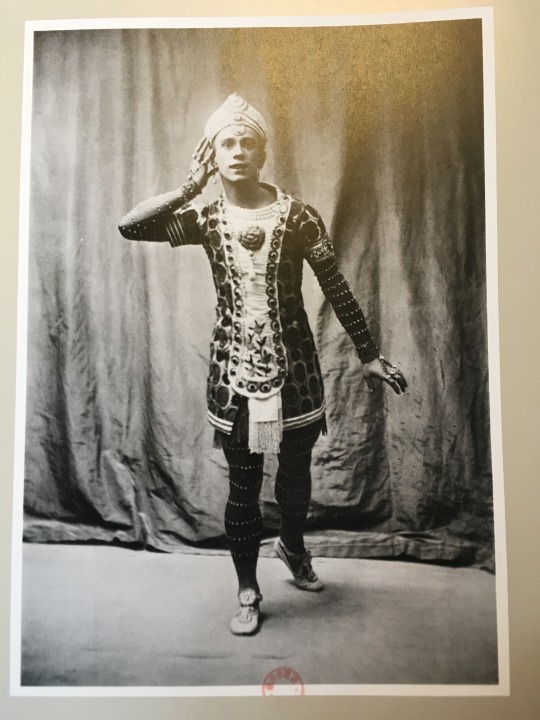
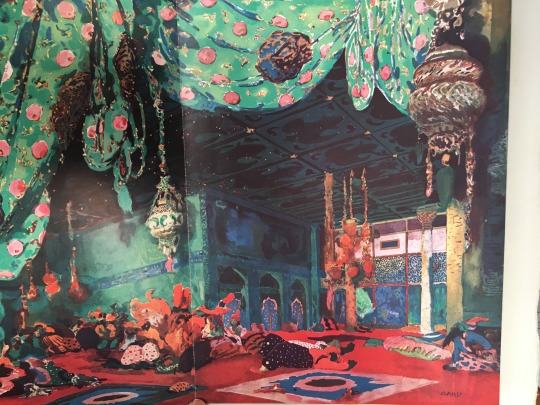
Second image of Nijinsky from Le Dieu Bleu, and Bakst’s set design from Scheherazade (1911). These are mainly photos and scans I have from the year I spent in the archives of the Palais Garnier (the Paris Opera) where all the good stuff is.
The crux of why these costumes are insanely interesting to me is because they are very specific to their time - they are a product of a resurgence in nationalist interests in Russian art (Diaghilev ran Mir Isskustva and worked with Savva Mamontov before he organised the BR) as well as a carefully crafted, highly artificial presentation of Otherness, expressly destined for export to the west. French audiences in the first decade of the 20th century (because there is a stark cut-off at the beginning of WW1) still had an appetite for Orientalism, despite their flagging colonial power. What the Russians brought them was compelling mix of performative Orientalism just vague enough to be appealing and fantastical, visually intriguing, and refreshing to a society that had otherwise come to recognise itself as decadent, fallen “victim” to modernity. In the athletic virtuosity of Russian bodies, Bakst’s exotic visual language and the soaring music of Rimsky-Korsakov and Stravinsky, the French devoured what they deemed a sort of noble savagery (yes, that kind). Despite the oversaturation of Orientalism in painting throughout the 19th century, the French identified a kind of masculine vigour and freedom in these live performances they found they themselves lacked, and longed for. Primitivism, as demonstrated in myriad ways by the BR, was for them a way to reconnect with a virility that they felt modernity had stolen, or at the very least, weakened. If you think this sounds eerily akin to the discourse around mounting desire for war to “cleanse” or “reset” Europe during that same period, you are right.
A few of Bakst’s lesser known designs from the archive, for context (including a reprod by Barbier which I don’t have the OG of but is saved in my Bakst folder so please take my word for it). I have a thousand more of these but tumblr has an image limit per post 😤

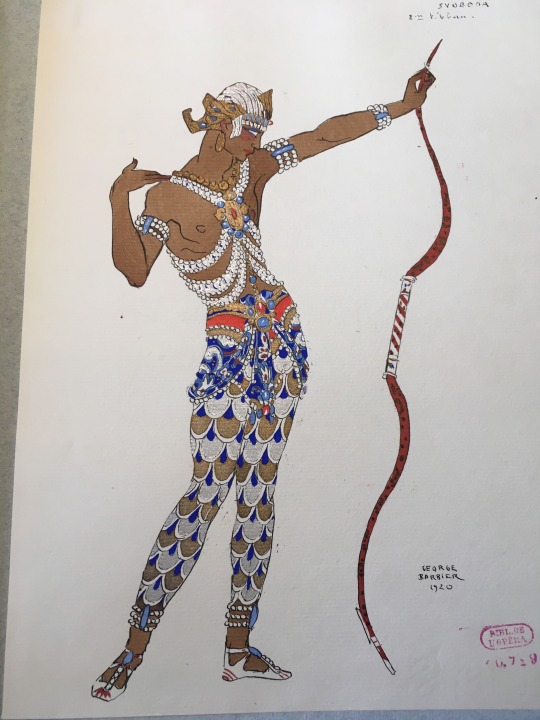

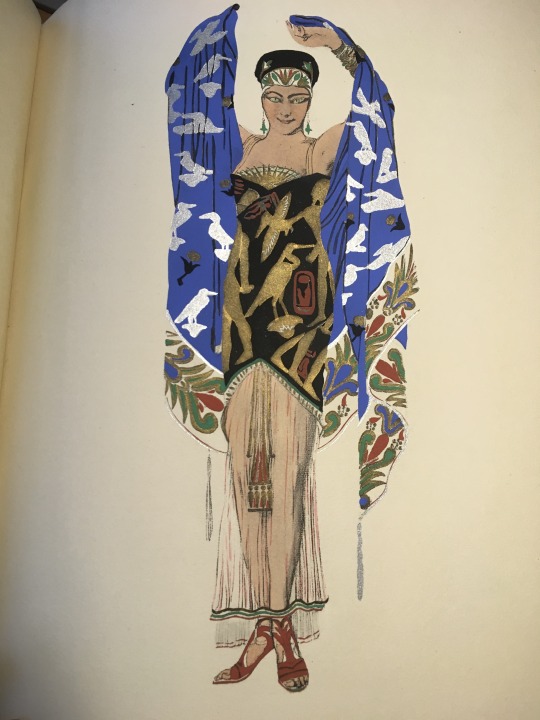

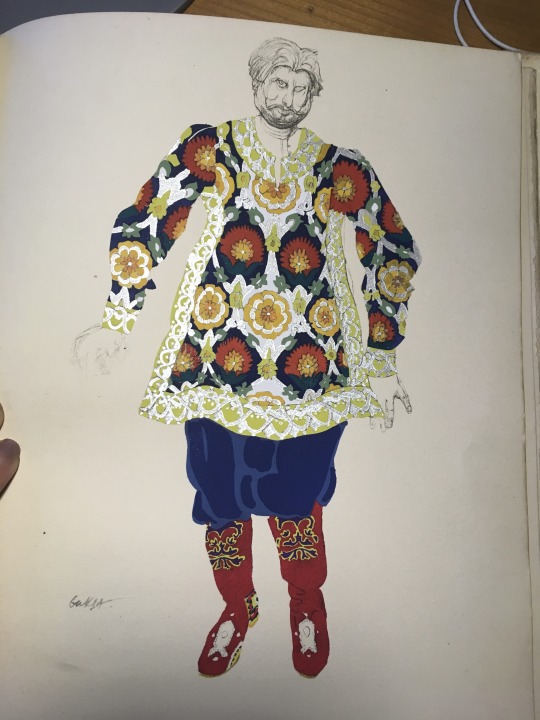
Tamara Karsavina, who often performed with Nijinsky, and one of my most beloved historical figures. The existence of a strong classical ballet cirruculumin the UK today is in part thanks to her.

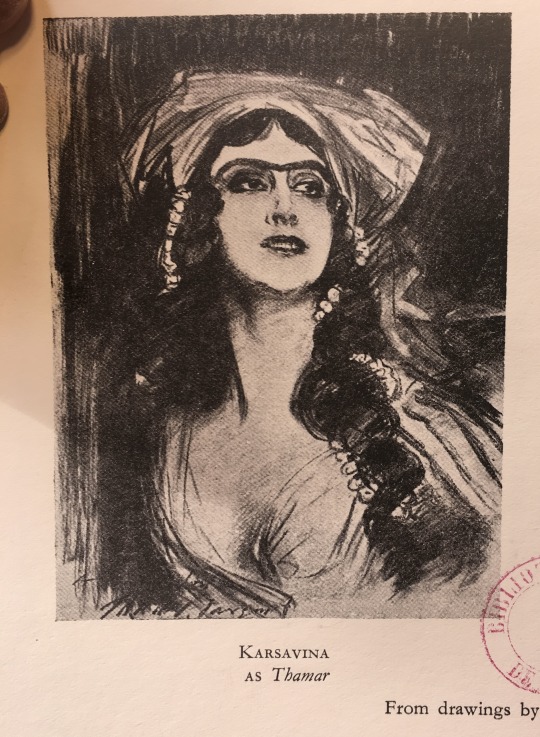
One of her most famous roles, as the Firebird:
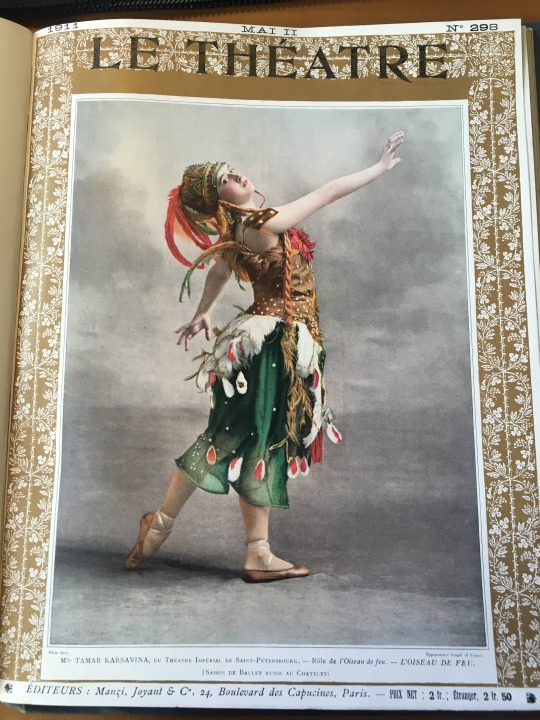
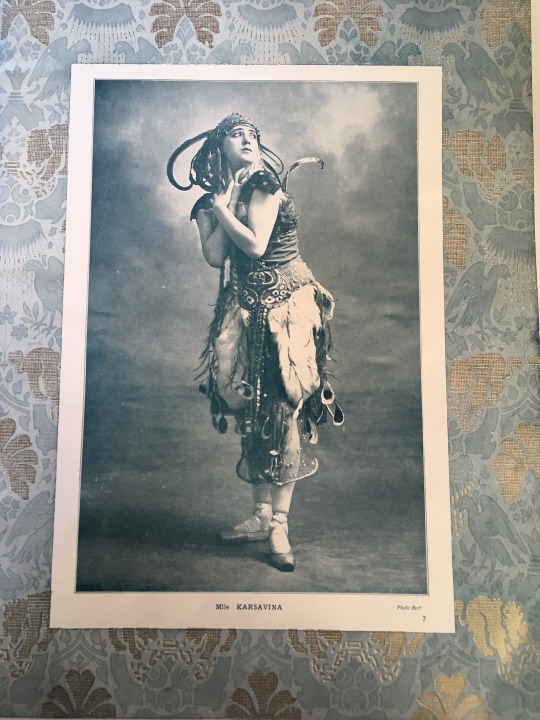
Nijinsky is by far the most interesting figure to come out of the BR. He combined virtuosity and strength (that most audiences identified as masculine) with a glittering, joyful, and expressive queerness on stage (and off). Some of his greatest roles are expressly feminine in their costume design: Le Spectre de La Rose, for example.
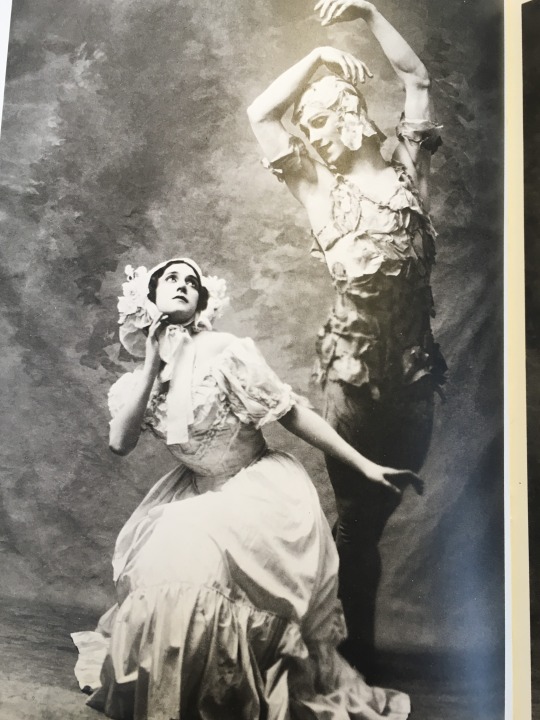
There’s a colorised version of this out there where you can see every pink rose petal on him.
While others are much more decorative but still markedly Orientalist (or Russian-Orientalist): Le Dieu Bleu, La Peri, Les Orientales, L’Oiseaux de Feu.

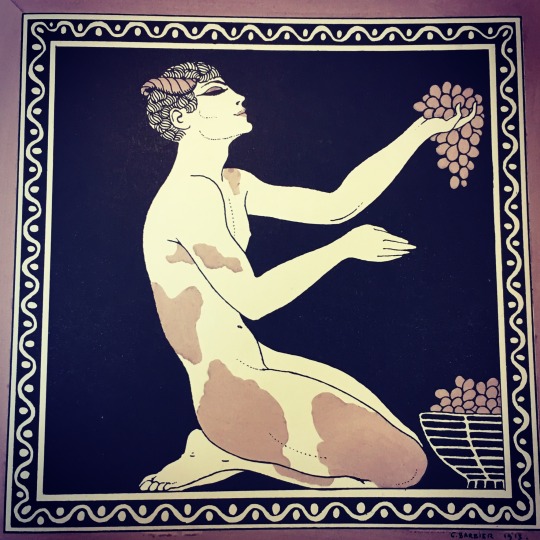
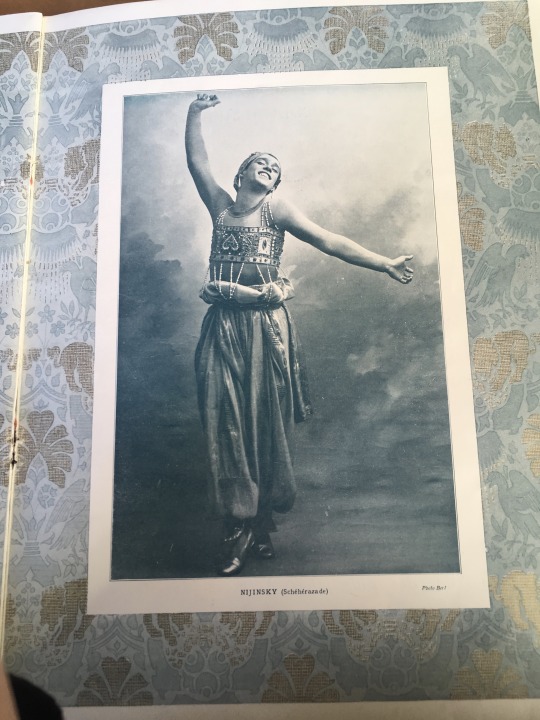

This last image above is not, the last I saw it, in a private collection. It hangs above the vestibule of the Palais Garnier archives (also Napoleon’s private hangout room) where it faces the sort of “diptych” version that features Karsavina, and on occasion I would stand below them and weep quietly).
Either way, there is an argument to be made about Nijinsky’s physicality and, more importantly nationality as a kind of avenue of permission through which the French could admire both his beauty and athleticism and even, to a degree, imagine themselves in his place while still maintaining that safe distance of Otherness.
But I would argue that his greatest role was the Golden Slave in Scheherazade, a wild, erotic orientalist fantasy that has little to nothing to do with the actual tale of Scheherazade. In it, Nijinsky - bejewelled, wild, ecstatic, (and yeah often in blackface) - cavorts with Zobeide, the Sultan’s favourite, in a very sexually explicit storyline. Both characters are equally decorative in their costumes, and both, in real life, were recognisably queer(ed) figures. It’s Scheherazade in particular that helped accelerate an obsessive trend in fashion (Paul Poiret was at the centre) for Orientalist design. Bakst himself did some silhouettes that are hard to distinguish from his costume design, and through the remarkable illustrations by Paul Iribe, Georges Lepape and Georges Barbier, we can see some of the blatant repetition of motif and silhouette in these ensembles that are designed, among other things, to be worn to the theatre.
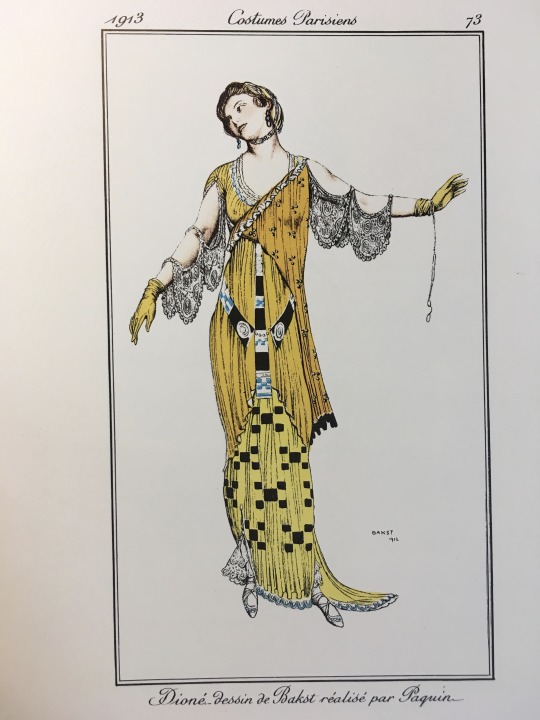
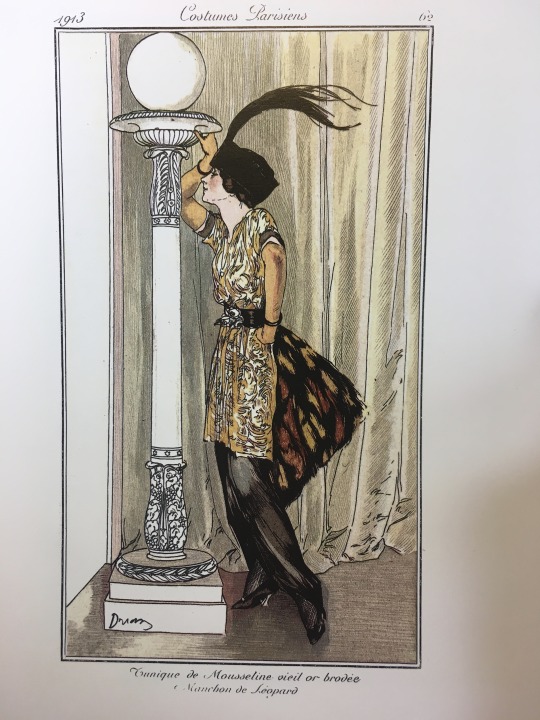
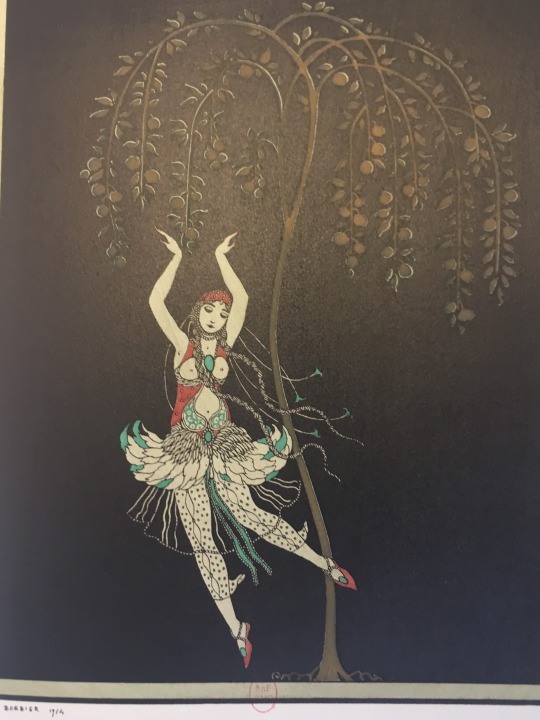
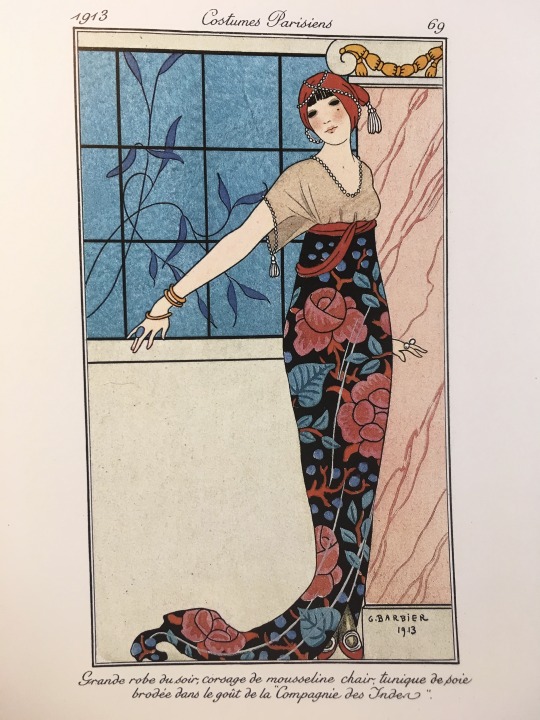
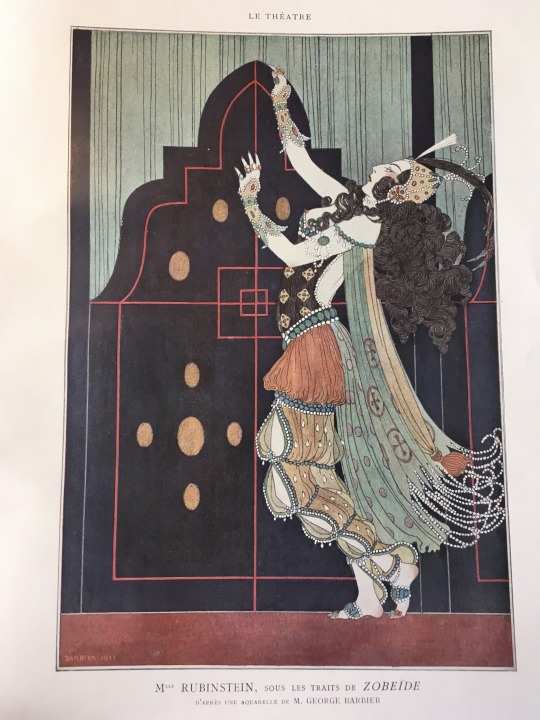
3rd and 5th are depictions of costumes of the Firebird and Zobeide respectively; the rest are fashion plates. This doesn’t even include the lampshade dress - which I don’t have a handy picture of, but have seen in real life - that is a pretty blatant melange of the Firebird and Zobeide, as designed by Poiret. Below is one of my favourite examples: A woman in a lampshade-style dress, standing against a backdrop not unlike Bakst’s set design above, attended by a archetypal oriental servant wearing Nijinsky’s Golden Slave costume.
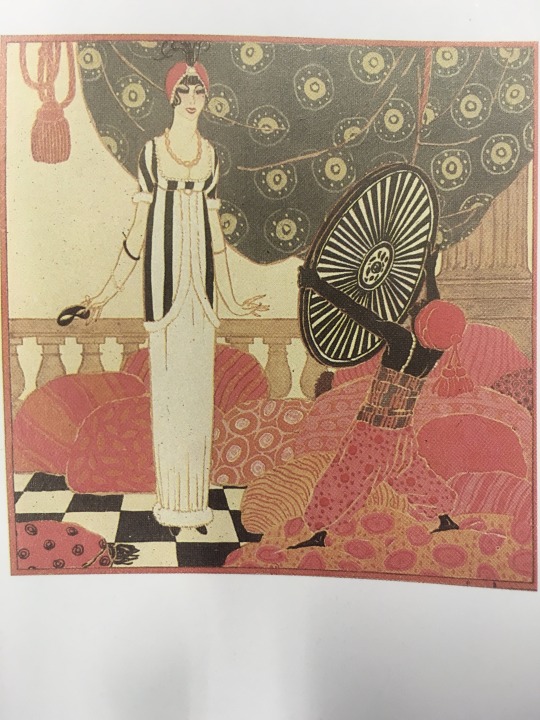
These motifs also proliferated in advertisements and in all kinds of other consumer products (perfumes, for example, and decorative objects). Thus, there’s a performative aim in wearing these designs that I read as a sort of pseudo-kinetic empathy (and can funnnily enough probably be compared to cosplay). There is an attempt here to channel what is being presented onstage, to reenact it, to physically embody it, in the way that fashion is, at its core, a tool through which to construct identity. That the French pulled inspiration from an openly queer man leaping across the stage dripping in jewels, and from femme fatal-style odalisques, says a lot about the visual and cultural impact the BR had on the theatre-going public at the time.
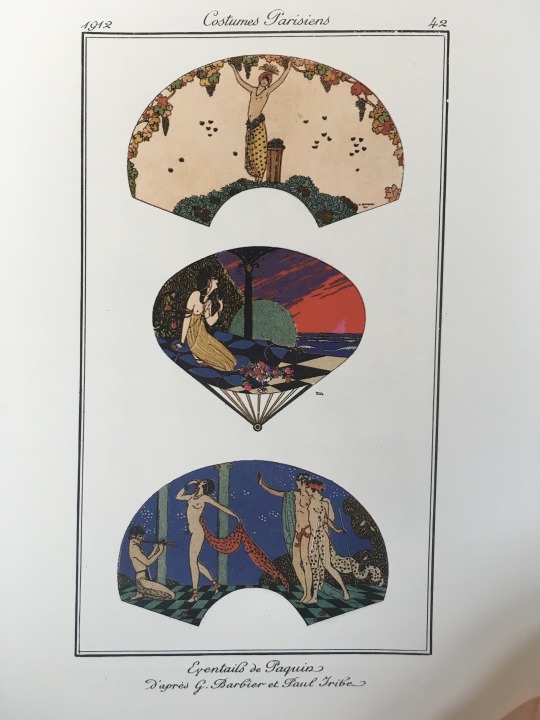
You can see in these fan designs by Paquin some pretty obvious references to the BR aesthetic: L’apres-midi d’un faune, Daphnis et Chloe, Scheherazade, even a little Le Pavillon d’Armide in that first one.
Nijinsky was not the only one to queer the stage: despite not being a dancer trained to the level of the BR troupe, Ida Rubinstein, no doubt purposefully channelling Sarah Bernhardt, was also a beloved stage presence, whether as the sly harem favourite Zobeide or as the strikingly androgynous St Sebastian, gayest of saints.

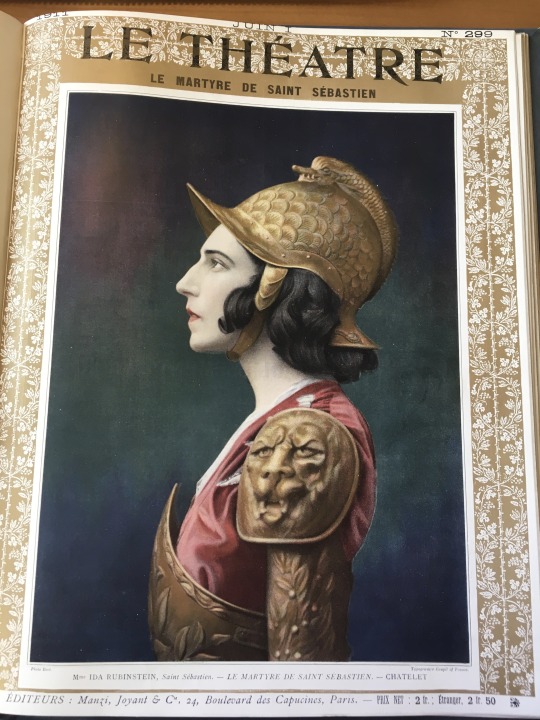
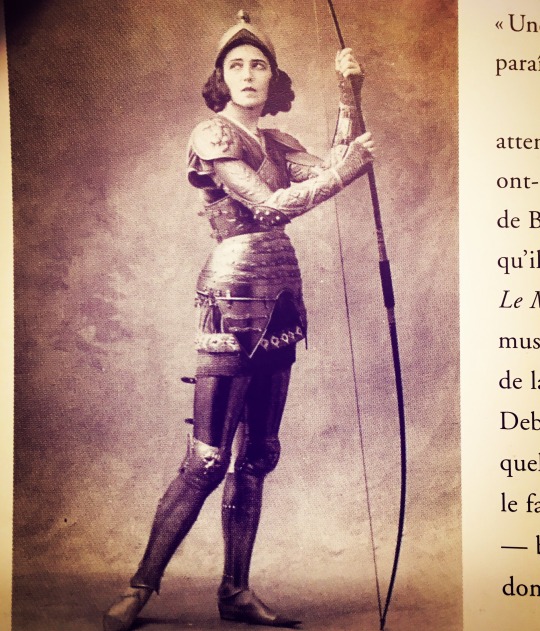
This is not to say there haven’t been wonderful and brilliant costume designs since - and quite a few known fashion designers working alongside dance companies, to great success or otherwise. I will, however, shoutout my favourite contemporary work: Akram Khan’s Giselle, which has everything and yet nothing to do with Adolph Adam’s 1842 piece. I don’t even want to post pictures because the costumes of the nobles (the landowners, in this very apocalyptically late-stage capitalist version) are so fucking breathtaking in relation to the overall design, and their entrance itself is probably one of the most spectacular parts of the ballet, that all I can say is just see it. Or buy the dvd. What Khan does gesturally is beyond words, what Vincenzo Lamagna does with Adam’s original score is visceral and haunting and churns my insides. I make a point to see it live at least once a season when it’s touring with the ENB, and I will do so until it leaves the repertory or until I die. It’s my contemporary Scheherazade. It’s a gesamtkunstwerk.
Tldr Leon Bakst is one of the greatest costume designers of the 19th and 20th century and criminally underrated.
It’s not ballet, and it’s not the sumptuous costumes from Boris Godunov, but as a bonus here’s my favourite image of opera star Fedor Chaliapine as Ivan the Terrible.
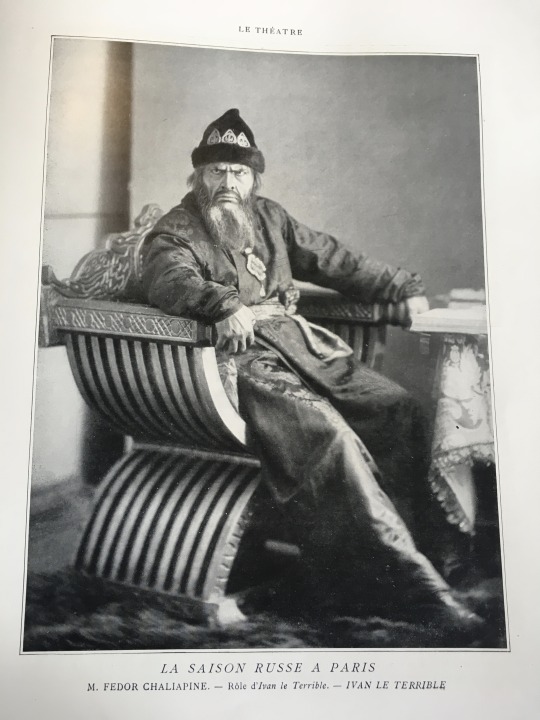
#Thank you for the enclosure enrichment#And for coming to the tldr of my thesis#ballets russes#vaslav nijinsky#Leon bakst#fashion design#academic indulgence hour#Art history
52 notes
·
View notes
Text

Wellington, on his bed, kicking his legs in the air: Teehee, promise?
#look man I’ve been grinding the stacks for a few days I need some enrichment#imagining some timid-yet-Important prof giggling as he unchains and steals a book detailing What Might Have Been is all I got#fallen london#professorial pursuits#the ragged academic
4 notes
·
View notes
Text
So yesterday I read "Slimed with Gravy, Ringed by Drink" by Camille Ralphs, an article from the Poetry Foundation on the publication of the First Folio in 1623, a major work without which most of Shakespeare's plays might very well have been lost today, possibly the most influential secular work of literature in the world, you know.
It's a good article overall on the history and mysteries of the Folio. Lots of interesting stuff in there including how Shakespeare has been adapted, the state of many surviving Folios, theories of its accuracy to the text, a really interesting identification of John Milton's own copy currently in the Free Library of Philadelphia, and the fascinating annotations that may have influenced Milton's own poetry!!! Do read it. It's not an atrociously long article but there's a lot of thought-provoking information in there.
There's one paragraph in particular I keep coming back to though, so I'm just gonna quote it down here:
...[T]he Play on Shakespeare series, published by ACMRS Press, the publications division of the Arizona Center for Medieval and Renaissance Studies at Arizona State University... grew out of the Oregon Shakespeare Festival’s plan to “translate” Shakespeare for the current century, bills itself “a new First Folio for a new era.” The 39 newly-commissioned versions of Shakespeare’s plays were written primarily by contemporary dramatists, who were asked to follow the reasonable principle laid out by series editor Lue Douthit: tamper in the name of clarification but submit to “do no harm.” The project was inspired by something the linguist John McWhorter wrote in 1998: “[the] irony today is that the Russians, the French, and other people in foreign countries possess Shakespeare to a much greater extent than we do … [because] they get to enjoy Shakespeare in the language they speak.”
Mainly it's the John McWhorter thing I keep coming back to. Side note: any of my non-native-English-speaking mutuals who have read Shakespeare, I would love to know your experiences. If you have read him in translation, or in the original English, or a mix of both. It's something I do wonder about! Even as an Anglophone reader, I find my experience varies so much just based on which edition of the text I'm reading and how it's presented. There's just so much variety in how to read literature and I would love to know what forces have shaped your own relationships to the stories. But anyway...
The article then goes on to talk about how the anachronistic language in Shakespeare will only fall more and more out of intelligibility for everyone because of how language evolves and yadda yadda yadda. I'm not going to say that that's wrong but I think it massively overlooks the history of the English language and how modern standard English became modern standard English.
First of all, is Shakespeare's language completely unintelligible to native English speakers today? No. Certain words and grammatical tenses have fallen out of use. Many words have shifted in meaning. But with context aiding a contemporary reader, there are very few lines in Shakespeare where the meaning can be said to be "unknown," and abundant lines that are perfectly comprehensible today. On the other hand, it's worth mentioning how many double entendres are well preserved in modern understanding. And additionally, things like archaic grammar and vocabulary are simply hurdles to get over. Once you get familiarized with your thees and thous, they're no longer likely to trip you up so much.
But it's also doubtful that 400 years from now, as the article suggests, our everyday language will be as hard to understand for twenty-fifth century English speakers to comprehend. The English language has significantly stabilized due to colonialism and the international adoption of English as a lingua franca. There are countless dialects within English, but what we consider to be standard international "correct" English will probably not change so radically, since it is so well and far established. The development and proliferation of modern English took a lot of blood and money from the rest of the world, the legacy of which can never be fully restored.
And this was just barely in sight by the time that Shakespeare died. This is why the language of the Elizabethans and Jacobeans is early-modern English. It forms the foundations of modern English, hence why it's mostly intelligible to speakers today, but there are still many antiquated figures within it. Early-modern English was more fluid and liberal. Spelling had not been standardized. Many regions of England still had slight variations in preferences for things like pronouns and verb conjugation. We see this even in works Shakespeare cowrote with the likes of Fletcher and Middleton, as the article points out. Shakespeare's vocabulary may not just reflect style and sentiment, but his Stratford background. His preferences could be deemed more "rustic" than many of his peers reared in London.
Features that make English more consistent now were not formalized yet. That's why Shakespeare sounds so "old." It's not just him being fancy. And there's also the fact that blank verse plays are an entirely neglected art nowadays. Regardless of the comprehensibility of the English, it's still strange for modern audiences uninitiated to Elizabethan literature to sit there and watch a King drop mad poetry about his feelings on stage by himself. The form and style of the entire genre is off.
But that, to me, is why we should read Shakespeare. We SHOULD be challenged. It very much IS within the grasp of a literate adult fluent in English to read one of his plays, in a modern edition with proper assistance and context. It is GOOD to be acquainted with something unfamiliar to us, but within our reach. I'm serious. I do not think I'm so much smarter than everyone else because I read Shakespeare. I don't just read the plain text as it was printed in the First Folio! The scholarship exists which has made Shakespeare accessible to me, and I take advantage of that access for my own pleasure.
This is to say that I disagree with the notion that Shakespeare is better suited to be enjoyed in foreign tongues. I think that's quite a complacent, modern American take. Not to say that the sentiment of McWhorter is wrong; I get what he's saying. And it's quite a beautiful thing that Shakespeare's plays are still so commonly staged, although arguably that comes from a false notion in our culture that Shakespeare is high literature worth preserving, at the expense of the rest of time and history. It is true that his body of work has such a high level of privilege in the so-called Western literary canon that either numerous other writers equally deserve, or no writer ever could possibly deserve.
The effort that goes into making Shakespeare's twenty-first century legacy, though, is a half-assed one. So much illustrious praise and deification of the individual and his works, and yet not as much to understanding the context of his time and place, of his influences, forms, and impacts on the eras which proceeded him. Shakespeare seems to exist in a vacuum with his archaic language, and we read it once or twice in high school when we're forced to, with prosaic translations on the adjoining page. This does not inspire a true appreciation in a culture for Shakespeare but it does reinforce a stereotype that he must be somehow important. It's this shallow stereotype that makes it seem in many minds today that it would be worth it to rip the precise language out of the text of a poet, and spit back out an equivalent "modern translation."
#this is just a stream-of-consciousness rambling. ignore me if im not making sense which im probably not#long post#text post#rant#shakespeare#also to clarify on that last point i am not shitting on the art of translation. AT all.#into other languages that is. nor am i knocking all modern adaptations of shakespeare's works#made with good intent. and also if you enjoy modern translated english shakespeare a la no fear shakespeare#genuinely good for you! that series has helped a lot of people and im glad for them to have that resource#HOWEVER. i WOULD like to challenge the idea that that is the best way to READ shakespeare#i think it's simply a shortcut.#and by all means take a shortcut if what you're reading shakespeare for is the plot. especially if youre new to him!#i DO on the other hand think it is entirely possible for any general reader to eventually be able to read shakespeare#in other types of editions. with the plain text and academic footnotes or annotations.#i do think enjoying the poetry of the works is as enriching as the characters or plot#in fact in the case of characters. the intricacies of the poetry of course enhance them!#you know. like i think the challenge is more doable than we ever really talk about in the mainstream#when you read him in high school you most likely had your english teacher holding your hand through every line#that's basically what the literal prose translations do too. in my opinion.#at least a la no fear shakespeare because those aren't meant to be performed like an equivalent art.#the translations are clarification.#again i think it's entirely possible to adapt the language of shakespeare and even a worthwhile project#but that's not. you know. the thing on the shelves to be read.#we can all still read shakespeare and we are all smart enough to do so.#if we think of early-modern english as another dialect rather than a whole different language#and there are so many mutually intelligible yet very distinct dialects of english around the world today#(the literature of which is also well worth reading) and if one seems approachable. well they all can be.
11 notes
·
View notes
Text
Beyond the Classroom: Exploring Enrichment Programs for Children
In today's fast-paced world, parents are increasingly seeking opportunities to provide their children with experiences that go beyond traditional classroom learning. Enrichment programs for children offer a wealth of benefits, from academic enrichment to creative exploration and social development. In this blog post, we'll delve into the world of enrichment programs, exploring the various types available, the benefits they offer, and how parents can choose the right programs for their children.
Understanding Enrichment Programs for Children
Enrichment programs for children are designed to complement and enhance traditional education by providing opportunities for additional learning, skill development, and personal growth. These programs come in various forms, catering to different interests, talents, and age groups.
Types of Enrichment Programs for Children
Academic Enrichment: Academic enrichment programs focus on enhancing children's academic skills and knowledge in specific subjects such as maths, science, language arts, and STEM (science, technology, engineering, and mathematics). These programs often incorporate hands-on activities, experiments, and projects to make learning engaging and interactive.
Skill-based Enrichment: Skill-based enrichment programs aim to develop children's practical skills and talents in areas such as music, art, sports, coding, robotics, and culinary arts. These programs provide opportunities for children to explore their interests, discover new passions, and develop valuable skills that can benefit them both academically and personally.
Creative Enrichment: Creative enrichment programs focus on nurturing children's creativity, imagination, and self-expression through activities such as drama, dance, theater, creative writing, and visual arts. These programs encourage children to explore their artistic abilities, experiment with different mediums, and express themselves in meaningful ways.
Benefits of Enrichment Programs for Children
Academic Enrichment and Cognitive Development: Academic enrichment programs provide children with opportunities to deepen their understanding of core subjects and develop essential academic skills such as critical thinking, problem-solving, and analytical reasoning. By engaging in hands-on activities, experiments, and projects, children not only reinforce what they've learned in the classroom but also gain a deeper appreciation for the subject matter.
Narrative: Emily, a sixth-grade student, struggled with maths in school. However, after enrolling in an after-school maths enrichment program, she discovered a newfound love for numbers. Through hands-on activities and games, she began to see maths in a different light, finding joy in solving problems and exploring mathematical concepts. As her confidence grew, so did her grades, and she soon became one of the top maths students in her class.
Skill-based Enrichment and Practical Learning: Skill-based enrichment programs offer children the opportunity to develop practical skills and talents that can benefit them in various aspects of their lives. Whether it's learning to play a musical instrument, mastering a new sport, or honing their coding skills, these programs provide a supportive environment for children to explore their interests, build confidence, and achieve their goals.
Narrative: James, an aspiring young musician, dreamt of playing the guitar but didn't know where to start. With the support of his parents, he enrolled in a music enrichment program at a local community center. Under the guidance of experienced instructors, James learned the fundamentals of music theory, technique, and performance. With each lesson, he grew more confident and proficient, eventually showcasing his skills at a recital for family and friends. Today, James continues to pursue his passion for music, playing in a band and composing his own songs.
Creative Enrichment and Artistic Expression: Creative enrichment programs provide children with opportunities to explore their artistic abilities, unleash their imagination, and express themselves in meaningful ways. Whether it's painting, drawing, acting, or dancing, these programs foster creativity, self-confidence, and a sense of identity.
Narrative: Sarah, a shy and reserved nine-year-old, struggled to express herself verbally. However, when she discovered a passion for painting in an art enrichment program, she found a new way to communicate and connect with others. Through her artwork, Sarah expressed her thoughts, feelings, and emotions in vibrant colors and bold strokes. With each painting, she gained confidence and a sense of empowerment, eventually sharing her work with the world at a local art exhibition. Today, Sarah continues to use art as a form of self-expression and advocacy, inspiring others with her creativity and courage.
Social and Emotional Development: Enrichment programs provide children with opportunities to interact with peers, collaborate on projects, and develop essential social and emotional skills such as communication, teamwork, empathy, and resilience. By participating in group activities, discussions, and games, children learn to navigate social dynamics, build meaningful relationships, and develop a sense of belonging and community.
Narrative: Daniel, a ten-year-old with autism spectrum disorder, struggled to connect with his peers and engage in social interactions. However, when he joined a theater enrichment program for children with special needs, he found a supportive and inclusive environment where he could express himself freely and connect with others through the power of storytelling. Through drama games, improvisation exercises, and group performances, Daniel learned to communicate effectively, collaborate with his peers, and express his emotions in constructive ways. With each rehearsal, he grew more confident and self-assured, eventually starring in a school play and inspiring others with his talent and resilience.
Overcoming Common Barriers to Participation
Despite the numerous benefits of enrichment programs, many parents face common barriers when it comes to enrolling their children in these programs. However, with proactive planning and creative solutions, these barriers can be overcome.
Financial Constraints and AffordabilityMany parents hesitate to enroll their children in enrichment programs due to financial constraints. However, there are often affordable or free options available, such as community-based programs, scholarships, and sliding-scale fees. Additionally, some programs offer payment plans or discounts for families with limited financial means. By exploring different options and resources, parents can find enrichment programs that fit within their budget and offer excellent value for money.
Time Constraints and Scheduling ConflictsBalancing children's enrichment activities with other commitments such as school, extracurriculars, and family obligations can be challenging. However, by carefully managing schedules and prioritizing activities, parents can create time for enrichment programs. Consider enrolling children in programs that offer flexible scheduling options, such as weekend classes, evening sessions, or online courses, that fit into your family's routine.
Access and AvailabilityAccess to enrichment programs can vary depending on factors such as location, transportation, and resources. However, there are often local community centers, libraries, schools, and online platforms that offer a variety of enrichment programs for children. Additionally, some programs provide transportation services or virtual options for families who may face barriers to access. By exploring different resources and reaching out to community organizations, parents can find enrichment programs that are accessible and inclusive for their children.
Choosing the Right Enrichment Program for Your Child
With so many enrichment programs available, choosing the right one for your child can feel overwhelming. However, by considering your child's interests, strengths, and areas for growth, as well as logistical factors such as location, schedule, and cost, you can make an informed decision that aligns with your child's needs and preferences.
Assessing Your Child's Interests and Goals: Start by talking to your child about their interests, passions, and goals. What subjects or activities do they enjoy? What skills or talents would they like to develop? By understanding your child's interests and aspirations, you can narrow down your options and focus on programs that are meaningful and relevant to them.
Researching Available Programs and Resources: Once you have a sense of your child's interests, research available programs and resources in your community. Look for programs that align with your child's interests and offer a comprehensive curriculum, experienced instructors, and positive reviews from past participants. Consider exploring online platforms and virtual programs that provide flexibility and convenience for busy families.
Considering Logistical Factors: When choosing an enrichment program, consider logistical factors such as location, schedule, and cost. Choose a program that is conveniently located and fits into your family's routine. Look for programs with flexible scheduling options, such as evening or weekend classes, that accommodate your child's other commitments. Additionally, consider the cost of the program and whether financial assistance or scholarships are available for families in need.
Seeking Recommendations and Reviews: Finally, don't hesitate to seek recommendations and reviews from other parents, educators, and community members who have experience with enrichment programs. Talk to friends, neighbours, and colleagues who may have enrolled their children in similar programs and ask for their insights and recommendations. Additionally, read online reviews and testimonials to get a sense of the program's quality and reputation.
Tips for Maximising the Benefits
Once you've chosen an enrichment program for your child, there are several strategies you can use to maximize the benefits and support your child's growth and development.
Set Clear Goals and Expectations: Start by setting clear goals and expectations for your child's participation in the program. What do you hope they will gain from the experience? Whether it's improving academic skills, developing a new talent, or building social connections, articulate your goals and discuss them with your child to ensure alignment and motivation.
Encourage Active Engagement and Participation: Encourage your child to actively engage in the program by participating in class discussions, completing assignments, and seeking feedback from instructors. Encourage them to ask questions, share their ideas, and collaborate with their peers. By taking an active role in the learning process, your child will deepen their understanding and retention of the material and develop important skills such as critical thinking and communication.
Provide Support and Encouragement at Home: Support your child's participation in the enrichment program by providing encouragement and support at home. Help them with homework or practice assignments, attend performances or showcases, and celebrate their achievements and progress. Create a positive and nurturing environment where your child feels empowered to explore their interests and pursue their passions.
Recognise and Celebrate Achievements: Finally, recognise and celebrate your child's achievements and milestones throughout the program. Whether it's mastering a new skill, completing a project, or overcoming a challenge, acknowledge their efforts and celebrate their successes. By celebrating their achievements, you'll boost their confidence, motivation, and sense of accomplishment, encouraging them to continue exploring their interests and pursuing their goals.
Case Studies: Real-Life Examples of Successful Participation
To illustrate the transformative impact of enrichment programs, let's explore some real-life examples of children who have benefited from their participation.
Academic Enrichment: Mia's Journey to Mathematical Mastery: Mia, a fourth-grade student, struggled with maths in school. However, after enrolling in an after-school maths enrichment program, she discovered a newfound love for numbers. Through hands-on activities, games, and projects, Mia gained a deeper understanding of mathematical concepts and developed essential skills such as problem-solving and critical thinking. With each lesson, her confidence grew, and she soon became one of the top maths students in her class. Today, Mia excels in maths and attributes her success to the support and encouragement she received in the enrichment program.
Skill-based Enrichment: Ethan's Quest for Musical Mastery: Ethan, a talented young musician, dreamt of mastering the piano but didn't know where to start. With the support of his parents, he enrolled in a music enrichment program at a local community center. Under the guidance of experienced instructors, Ethan learned the fundamentals of music theory, technique, and performance. With each lesson, he grew more confident and proficient, eventually showcasing his skills at a recital for family and friends. Today, Ethan continues to pursue his passion for music, playing in a band and composing his own songs, thanks to the foundation he built in the enrichment program.
Creative Enrichment: Ava's Journey of Self-Discovery through Art: Ava, a quiet and introspective eight-year-old, struggled to express herself verbally. However, when she joined an art enrichment program, she found a new way to communicate and connect with others through painting and drawing. Through her artwork, Ava expressed her thoughts, feelings, and emotions in vibrant colours and bold strokes. With each painting, she gained confidence and a sense of empowerment, eventually sharing her work with the world at a local art exhibition. Today, Ava continues to use art as a form of self-expression and advocacy, inspiring others with her creativity and courage.
Conclusion
Enrichment programs for children offer a wealth of benefits, from academic enrichment to creative exploration and social development. By providing children with opportunities to explore their interests, develop new skills, and connect with others, these programs play a crucial role in supporting their growth and development. Whether it's mastering a new subject, discovering a passion, or building lifelong friendships, enrichment programs empower children to reach their full potential and thrive in all areas of their lives. So why wait? Explore the world of enrichment programs and give your child the gift of limitless possibilities.
#Enrichment#Academic#Skill-based#creative exploration#childhood education#social development#afterschool activities#Extracurricular#holistic learning#Youth development#personal growth#Learning opportunities#Child enrichment activities
3 notes
·
View notes
Text
ok 18% done with the go-betweens and now i will attempt to relax by forcing myself to read a spy novel 😐
i really just want to read spirk fanfiction tho 🫠
#adventures in post-academic academia#i don't know why i have such a visceral disgust towards spy novels#that entire genre of#extreme#near cosplay#of masculinity#ughhhhhh#don't wannaaaaaaa#pout.gif#something something#enrichment in my enclosure
2 notes
·
View notes
Note
Hi Abby I realized recently that reading your blog over the years has changed the way I view romance and love and now I embrace the romance in all of my relationships and situations and it's a lot more fun and cool than doing it any other way! So thank you, I feel like my life is richer now. Even the experience of reading a stranger's Tumblr can be romance ❤️
and this is a love letter i’m going to treasure so much. thank you deeply for this ❣️
#i love you all so much truly#you enrich my life!!! thank you!!!#huge win for me…academic scholar of love
8 notes
·
View notes
Text
The evil has been defeated...... I've returned the book to the library...........
#love working a hundred yards away from the library. means i can dispose of the bloated corpse of academic writing immediately.#i rarely dnf books and it's specifically cuz ranting is just as much enrichment as reading is for me but good god i came close#megs is reading
18 notes
·
View notes
Note
it's incredibly gratifying to see someone whose brain was set on fire as badly, if not worse, as mine was when i started reading umineko, who also has the academic background to give the story this kind of scrutiny. this is fantastic to watch/read, thank you for sharing your thoughts. it might take you years, plural, to finish, but you definitely have the passion to see it through to the end.
you know technically if you really examine the timeline of events these last few months there's a case to be made that my desire to analyse and understand umineko on this level could be seen as a contributing factor in me deciding to apply for a phd lmao.
and i'm glad you're enjoying my thoughts! i am also enjoying thinking them and the whole experience of chewing through a text as meaty as umineko. i sometimes worry that my methodical laborious pace is gonna put people off because it's going to take me far too long to get to the Good Moments people want to see livebloggers react to (let it not be forgotten that it took me over 2 months just to hit the first death) but it's reassuring to know that people are appreciating the way i'm doing this!
#lastendlibrarian#'brain on fire' really is the best way to describe it#literally every time i think about umineko it's as if there's a rapidly expanding psychic supernova happening in my head lol#honestly umineko is such a perfect form of enrichment for my little academic weirdo enclosure
9 notes
·
View notes
Text
just pussy cunt bossed ate left no crumbs slay mama boots the house down houston deceased my paper 2 english lit final 😎 wrote a solid 3 pages of long and girthy paragraphs for a comparative analysis on the worlds clunkiest dell computer that would eat and delete sentences if i tried to add text in the middle of a paragraph. most adrenaline inducing 2 hours of my life
#i have never accurately predicted a grade in my life and i tend to underestimate english grades and overestimate math/science#the amount of times i've written an analytical essay requiring evidence and justification for the points i make on a book#that i did not even begin reading and then gotten a the IB equivalent of an A#truly extraordinary#i need this for my mental health and enrichment otherwise i'll have a breakdown over my steadily declining academic performance
1 note
·
View note
Text

Best Intermediate College in India #trending#viral#india#vizag#visakhapatnam#andhrapradesh#bestcollege
https://manasadefenceacademy1.blogspo...
We will be discussing the best college in India, Manasa Junior College. Manasa Junior College is renowned for providing top-tier intermediate education to students, ensuring a holistic learning experience that prepares them for a successful future. Join us as we explore the exceptional programs, faculty, and facilities that set Manasa Junior College apart as a premier educational institution in India.
Call : 77997 99221
Website : www.manasajuniorcollege.com #bestintermediatecollege #manasajuniorcollege #educationinindia #intermediateeducation #studentsuccess #educationmatters #academicexcellence #holisticlearning #careerreadiness #academicprograms #discovermanasajuniorcollege #collegeinindia #studentlife #academicjourney #learningexperience #premierinstitution #futureleaders #successstories #educationalgoals#trending#viral
#manasajuniorcollge#best education#bestcollge#bestjuniorcollege#trending#bestclasses#viral#academic excellence#commerce#best junior college#Best intermediate college#India#Manasa Junior College#Education#Students#Intermediate education#Top-tier college#Holistic learning#Successful future#Premier educational institution#Enriching programs#Experienced faculty#State-of-the-art facilities#Exceptional education#Academic excellence#Career readiness#Student success#Higher education#Learning experience#Academic programs
0 notes
Text
Celebrating Dr. Don Bailey: A Legacy of Health and Inspiration

View On WordPress
#academic excellence#Academic mentorship#academic research#Active lifestyle#Ankylosing spondylitis#Bone health#Bone Mineral Accrual Study#Campus events#Canadian initiative#Childhood friends#Childhood growth#Childhood physical activity#College of Kinesiology#Community Engagement#Community Involvement#Community Pride#community well-being#Cultural enrichment#CULTURAL HERITAGE#Determination#Don Bailey#Don Bailey Lecture Series#Dr. Adam Baxter-Jones#Dr. George Genereux#environmental charity#environmental conservation#environmental stewardship#Fitness evaluation#Fitness levels#Fitness research
0 notes
Text
will graham in my dream and i think he was in love with me HAHA
#like heyyyyyy#plot of the dream did not make sense at all tho also i had a heart problem that’s so 2018 felix#im so serious im like one hannibal related dream away from putting a hugh dancy looking guy in WS or something#like enrichment for the gay enclosure. a new chew toy.#sorry hugh dancy is such a rich airy british boys name thats so funny to me#wait what's hugh's background if i find out he's the grandson of a baron or something i'm killing myself#okay granddad has a wiki page but its academics thats not as bad as it could be#when it comes to british nepotism#staffordshire....interesting....think i drove through there to get to uni#of course he went to boarding school.....hugh michael horace dancy#the dragon school?? this country is not beating the goofy whimsical names for locations and institutions allegations#WAIT HAMPSHIRE THAT'S KIND OF NEAR ME YOU'RE JOKINGGG#hugh dancy did you ever have a little summer trip to lyme regis or similar jurassic coast towns x
0 notes
Text
Does anyone else feel like jumping out of their skin after they talk a lot about themselves or their experiences to other people irl ? Hi. Hello. Oomfs . ?
#i joked around w my pakistani coworker abt how i grew up in a super STEM focused environment bc of stereotypical desi parenting#and like i mentioned my past in a highly competitive enriched academic high school + just stuff i studied in general#like tidbits abt my educational experiences until now#chitchatted abt silly student stories#but i fear i came off as over talkative and unserious or just straight up pathetic or stupid#bc the coworker who i was speaking with is a middle aged man and he seems very calculated and composed#hes really nice but he scares me.#like no power dynamic situation bc we're both just regular old tutors#but hes in his 40s and he has a phD and a few degrees and he talks in such an eloquent way#idk i fear i come off as an idiot 19 year old who shares too much stuff even tho he started and continued the conversation#z.post
0 notes
Text
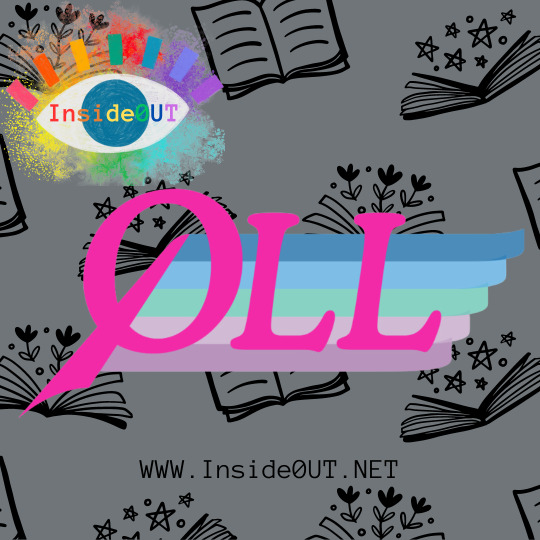
The Queer Liberation Library (QLL) is a digital treasure trove of over 1,200 LGBTQ books, providing a valuable resource for individuals across the country to access. This unique collection offers a diverse range of literature that celebrates and explores the LGBTQ experience in all its complexity. QLL has attracted over 50,000 readers, providing safe access to queer literature regardless of location or circumstances.
Unlike traditional libraries, the Queer Liberation Library is specifically curated to center LGBTQ voices and experiences. With a focus on inclusion and representation, this digital catalog offers a wide range of genres, from fiction and poetry to memoirs and academic texts.
While the collection is extensive, here are a few notable titles:
"A Burst of Light" by Audre Lorde
“One Last Stop” by Casey McQuiston: A contemporary novel with LGBTQ themes.
QLL continually adds new titles to enrich its catalog and cater to diverse interests
QLL was founded by a team of nine volunteers in response to state laws and school policies challenging books with LGBTQ themes. By providing access to a wealth of LGBTQ literature, the Queer Liberation Library offers readers the opportunity to explore diverse perspectives, gain insight into different lived experiences, and foster a greater understanding of the LGBTQ community. It offers free digital access to over 1,200 LGBTQ books for readers across the United States. Whether you are looking for resources for research, personal enrichment, or simply to broaden your literary horizons, this digital library has something to offer everyone.
Representation matters, and the Queer Liberation Library plays a crucial role in amplifying LGBTQ voices and stories. Unlike many public libraries, QLL specifically curates books with queer themes or written by queer authors. By providing a platform for LGBTQ authors and their work, this digital catalog helps to create a more inclusive literary landscape and promotes greater visibility for the LGBTQ community.
With over 1,200 books to explore, the Queer Liberation Library is a valuable resource for anyone seeking to learn more about LGBTQ history, culture, and identity. Whether you are a member of the LGBTQ community or an ally looking to educate yourself, this digital library is a rich source of knowledge and inspiration. 🌈 📚
Check it out HERE: www.queerliberationlibrary.org
@queerliblib
#lgbtq community#lgbtq#self love#lgbtq positivity#lgbt pride#queer pride#queer community#lesibian#lesbian pride#gay pride#bookblr#books#booklr#indie books#reading#books and reading#bookworm
2K notes
·
View notes